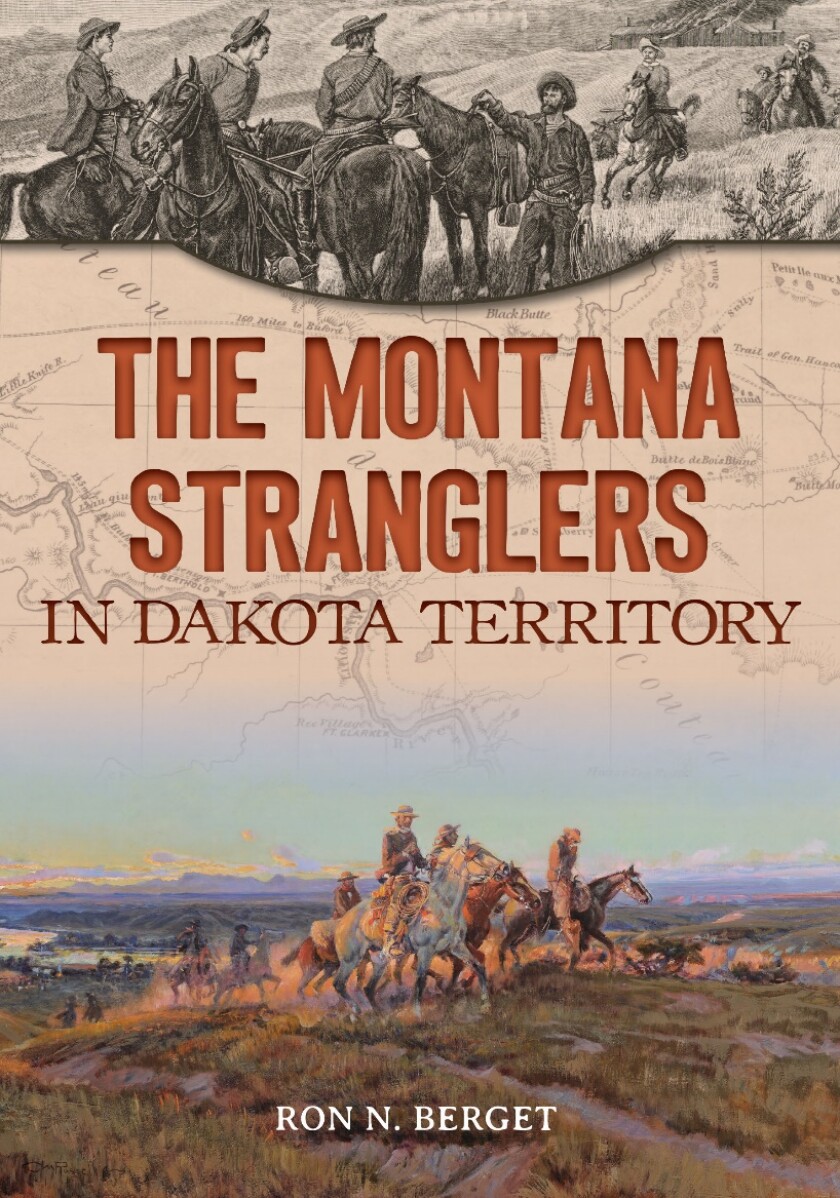Editor's note: The archival Vault article was first published Dec. 17, 2022.
ALEXANDRIA, Minn. — The fates of three men became entangled with deadly consequences for one of them, a man once trusted to run a Pony Express mail route out of Fort Stevenson in Dakota Territory.
ADVERTISEMENT
That man was Francis Gardipee, a mixed-race frontiersman whose buffalo-hunting way of life died off and who, for some reason lost to history, fell in with a gang of horse thieves.
His body was one of three that turned up in a grisly discovery in the spring of 1886 by a pair of fishermen who were trying their luck on Crooked Creek in western North Dakota’s McLean County.
The other two men whose lives intersected with Gardipee were Edmund Hackett, an ambitious and conniving businessman who was the first constable of rough and rowdy Bismarck, and Flopping Bill Cantrell, a woodchopper-turned vigilante.
The interconnected lives of the three men were pieced together by Ron Berget, a former wildlife manager and minister who lives in Alexandria, Minnesota. “They were like little strings you would follow,” he said of the clues he collected.
Berget’s boyhood imagination was ignited by the colorfully named Hangman’s Point on Crooked Lake near the farm where he grew up.

His father thought the name Hangman’s Point could have some connection to a story about a posse of cowboys from the Minot area who cornered a horse thief and hung him from a cottonwood tree.
Years later, while in high school, the picture began to come into focus when Berget read a local history book that briefly noted a posse of cowboys from the Minot area caught not one, but three suspected horse thieves they murdered.
ADVERTISEMENT
That discovery was the beginning of a years-long quest to learn more of the colorful history of cowboy vigilantes who roamed the Dakota Territory Badlands and beyond during the lawless era of the open range in the 1880s.
After more than two decades of periodic research, Berget thought someone should write a book about this overlooked facet of western North Dakota history, and decided that someone should be him. The result is a nonfiction work, “Montana Stranglers in Dakota Territory.”
Berget found snippets of the story scattered among county histories.

He discovered that the cowboy vigilantes in North Dakota largely were a spillover from the notorious Montana Stranglers, ranchers who took the law into their own hands to confront the thieves who were actively stealing horses and cattle and all too often going unpunished.
“There was kind of a rash of these things all over,” he said.
The vigilante movement on the open range started in north-central Montana in response to a gang of thieves that formed in 1883, including the other two men whose bodies ended up in that watery grave in Crooked Lake.
The gang collected a herd of stolen horses, then relayed them into Dakota Territory, hiding them in a string of camps as they worked their way down the Missouri River — the beginning of a violent cat-and-mouse interplay between the thieves and the vigilantes who pursued them relentlessly.
ADVERTISEMENT
The Montana vigilantes were led by Granville Stuart, a miner who became a land baron and cattle rancher who helped form the Montana Stock Grower’s Association. His followers were called Stuart’s Stranglers, since many of their victims died at the end of a rope.

From the fall of 1883 to December of 1884, by Berget’s tally, the vigilantes and the horse thieves they hunted killed 54 victims, and possibly more, in the Upper Missouri country and Souris River country.
Most were murdered “without law,” as the euphemism of the time put it. “This story does not have many good guys,” Berget warns readers in the opening pages.
Theodore Roosevelt, who ranched in the Little Missouri Badlands of Dakota Territory, was active in the Montana Stock Growers Association, but had nothing to do with the lawless vigilante movement, according to Berget.
That contradicts a myth that Roosevelt dabbled with the vigilantes, a false notion that spread after one of Roosevelt’s early biographers passed along an erroneous story by Stuart’s widow — a falsehood first debunked by Doug Ellison, a Medora historian who wrote “ .”
Berget agrees the evidence shows Roosevelt couldn’t have consorted with the vigilantes. But he found evidence that a famous contemporary of Roosevelt, the Marquis de Mores, invited the Stranglers to come to Medora after thieves reportedly stole 100 of his horses. To entice the vigilantes, the Marquis provided horses — the most prized of which, a white saddle horse called Snowball, which was stolen from a barn and later recovered.

The interconnected lives of Gardipee, who Berget considers an “everyman caught in the web of cultural change,” and those of the opportunistic Haskell and vengeful Cantrell drive Berget’s narrative.
ADVERTISEMENT
Gardipee was a Métis, descended from Plains Ojibwe, Plains Cree and French fur traders, who carried mail in the vicinity of Villard, a community on Turtle Lake.
During winter, the only way to transport mail in the area was by dogsled from Washburn, 75 miles to the south, a treacherous undertaking that Gardipee survived by drawing upon skills he acquired as a buffalo hunter, army scout and Pony Express rider.
The Great Northern Railway was pushing west from St. Paul to Seattle, prompting speculators to establish townsites along the suspected path, hoping to lure the railroad. Hacket was exploring possible railroad routes through the Souris River country in 1881 and his wanderings took him to the site of Gardipee’s log home, near which he drove a stake in the ground and proclaimed the village of Villard.
In the winter and spring of 1882, Hackett returned to Villard with American settlers and Norwegian immigrants, and houses and shops began to dot the prairie. Hackett’s claim included the site where Gardipee was squatting — a stake that turned Gardipee into an obstacle and placed him in conflict with the ambitious entrepreneur.
Then an opportunity presented itself to Hackett. Some of Gardipee’s friends, who found buffalo and other game nonexistent or scarce, fell in with some rustlers. Desperation might have had something to do with the turn to lawlessness, Berget believes.
Gardipee was jailed, but released after a month — but he was now branded as someone who consorted with horse thieves.
The Red River buffalo herd, which numbered in the hundreds of thousands in 1864, had disappeared by 1867, and the Montana herd had abruptly vanished in 1882, a disaster for the Métis and Plains Indians.
ADVERTISEMENT
“Nobody expected it to happen that fast,” Berget said in an interview. “Everybody was left flat-footed. They literally were starving to death.”
Gardipee’s hilly home country and the rugged ravines of nearby Dogden Butte provided perfect places to hide stock before driving it up into Canada, beyond the reach of American law.
Gardipee’s association with horse thieves would prove costly. In November 1884, he was taken into custody by Flopping Bill Cantrell’s posse of vigilantes and used as bait to apprehend two horse thieves who earlier had eluded capture.
The bodies of the two horse thieves were those found almost two years later, along with Gardipee’s, in the frigid waters of Crooked Lake.
Berget suspects that Hackett, eager to get Gardipee’s land for his townsite, used Cantrell’s posse as the means to remove an obstacle.
The Métis, like the Lakota and other Plains tribes, had a long tradition of stealing horses, which was viewed as a sport and a way for a young man to acquire honor. So it probably didn’t seem sinister for Gardipee and his friends to work with horse thieves, according to Berget.
“It was just part of their culture to steal horses,” he said. “They just continued to live the way they always lived and got into trouble.”
ADVERTISEMENT
Evidence against suspected horse thieves was often thin, as illustrated by the 1884 case of a suspected horse thief in McLean County.
A man named Tom O’Neil was riding with a string of three horses on a trail along the Missouri River leading to Bismarck. A passing stagecoach driver regarded O’Neill as suspicious, and tipped off vigilantes in Coal Harbor.
The vigilance committee — headed by a local doctor who also taught school — summarily tried O’Neill. The three horses in his possession had McLean County brands, but he couldn’t produce a bill of sale, and so was pronounced guilty and hanged from an abandoned telegraph pole, his dangling body left as a stark example.

O’Neill’s body was found the next day by a postmaster. Some locals believed he was innocent. For that matter, Berget isn’t persuaded that Gardipee was guilty.
“It’s not clear that Gardipee was a horse thief,” he said, adding that he believes Hackett used the Stranglers to get rid of him.
The deadly retribution dealt by the cowboy vigilantes has been romanticized, inspiring the plots of western novels and movies.
But Berget isn’t a fan of the lawless justice of the Stranglers. They could — and should — have taken the suspected horse thieves and delivered them to officers of the law, he said.
“There was some law out there,” Berget said. “Not nearly enough to control all the horse thieves.”
Still, he added, “They didn’t need to murder the people they arrested.”
"Montana Stranglers in Dakota Territory" can be purchased online from The History Press at . Copies autographed by the author are available at .














